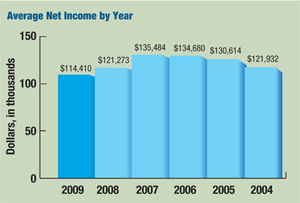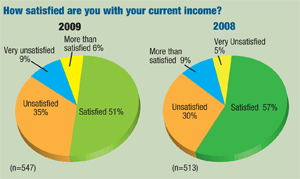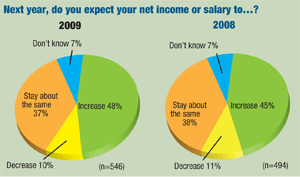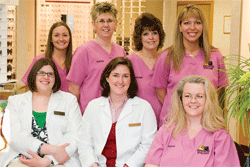Last year’s economic prediction came true: “In the midst of a recession, some people will reduce or defer their spending on optometrist services, hurting industry revenue in 2009,” according to a January 2009 industry report by IBISWorld.
Indeed, according to our survey, annual net income for the average optometrist dropped 5.6% from 2008 to 2009—from $121,273 down to $114,410. That’s on top of a 10.5% drop from 2007 to 2008. By comparison, net income in 2007 averaged $135,484—so that’s a $21,000 pay cut in two years for the average O.D.
The drop in income reflects a drop in sales. IBISWorld’s prediction for eyeglass and contact lens sales was that “Revenue is forecast to fall strongly in 2009, similar to the recession in 2001.” (Actually, the 2001 recession didn’t hit optometrists as hard as it did the national economy. That year, average net income for O.D.s didn’t decline—it still increased, albeit by 1.1%, according to our 2001 income survey.)
Perhaps revenue didn’t fall quite as “strongly” in 2009 as IBISWorld predicted. Between the end of 2008 and the end of 2009, the dollars spent in the entire U.S. vision care market fell just 2.1%, according to Consumer Barometer, a quarterly report of the U.S. optical industry by Jobson Research and the Vision Council. (Bear in mind that “just 2.1%” represents more than $684 million of the total $32+ billion U.S. vision care market.) In particular, frame sales declined by 1.5%, ophthalmic lenses were down 3.7%, sunglass sales dropped 5.4% and refractive surgery revenue fell 16.7%.
On the upside, contact lens sales were up by 3.5% in 2009, and revenue from eye exams rose 5.1%.
Still, both self-employed O.D.s and employed O.D.s saw a double-digit decline—around 16%—in net income since 2007.
These are some of the results of Review of Optometry’s annual Income Survey. The survey was e-mailed to more than 31,000 readers, and more than 1,050 optometrists responded—our largest response ever.
| Highlights of Review of Optometry’s 2009 Income Survey
|
||
| Average Net Income
Median Net Income |
$114,410
$93,000 |
(n = 800)
(n = 800) |
| Average Net Income by Years in Practice
|
||
| Less than 10 years
11 to 20 years 21 to 30 years More than 30 years |
$85,956
$125,460 $140,918 $135,580 |
(n = 275)
(n = 181) (n = 184) (n = 105) |
| Self-employed O.D.s Average Net Income
|
||
| All self-employed O.D.s
Solo practitioner Partner/group practice Franchisee Independent contractor Other |
$127,981
$124,262 $144,305 $110,544 $72,126 $76,333 |
(n = 507)
(n = 288) (n = 166) (n = 22) (n = 16) (n = 12) |
| Employed O.D.s Average Net Income
|
||
| All employed O.D.s
Other O.D. or M.D. Commercial firm HMO/PPO Other |
$90,931
$91,285 $83,513 $102,424 $91,332 |
(n = 291)
(n = 162) (n = 45) (n = 22) (n = 52) |
| Average Gross Revenue – All O.D.s
|
$433,646 | (n = 665)
|
| Median Gross Revenue – All O.D.s
|
$350,000 | (n = 665) |
| Self-employed O.D.s Average Gross Revenue
|
$486,794 | (n = 467) |
| Self-employed O.D.s Median Gross Revenue | $425,000 | (n = 467) |
| Employed O.D.s Average Gross Revenue
|
$307,743
|
(n = 197) |
| Employed O.D.s Median Gross Revenue
|
$125,000
|
(n = 197) |
Very Unsatisfied
The economy has many O.D.s in a funk. Salary satisfaction is just about at an all-time low. In 2007, before the sour economy really kicked in, nearly 68% of optometrists reported they were “satisfied” (60%) or “more than satisfied” (7.5%) with their current income.
No longer. In 2009, only 57% said they were “satisfied” (51%) or “more than satisfied” (6%). As many as 44% were either “unsatisfied” (35%) or “very unsatisfied” (9%).
One solo practitioner says, “I made less in 2009 than I made in 2005 due to the downturn in the U.S. economy, and this year looks worse yet. I don’t see any daylight in the near future!”
Other O.D.s have had not only a drop in revenue, but other unforeseen factors that put the squeeze on their bottom line.
It’s been one thing after another for Faye Algranati, O.D., a private practitioner in Wilton, Conn. “I lost business due to the recession, [and then] the landlord raised the rent, which required me to move,” she says. “This in turn caused many patients to decide not to travel longer to reach me.”
Says optometrist Dennis Iadarola, of Monroe, Conn., “It is getting harder to please people as well as counter insurance company cuts. I feel as though I’m working for the insurance companies and the government rather than the patient and myself.”
The economy has also delayed the dreams of many an O.D. who recently hung out a shingle. “We opened cold one-and-a-half years ago,” says Leslie Falcon, O.D., of her solo practice in Chandler, Ariz. “I can’t wait until my practice grows enough to pay me a reasonable salary,” she says.
“I started a new practice two years ago,” says a solo O.D. whose income is still in the teens. “The initial startup costs [have been] quite burdensome in light of the tanked economy.”
A Grain of Salt
The word “salary” comes from the Latin word for salt because soldiers in Ancient Rome were originally paid in salt. (This is where the phrase “worth his salt” comes from.) With the current economy, many optometrists are taking their incomes with a grain of salt—they’re just thankful for what they’ve got. “Considering the economic situation in Michigan (16% unemployment) I’m quite satisfied to do as well as the practice did,” says optometrist Rocky Hansen, of Greenville, Mich.
“One can always do better,” reasons Michael B. Maizel, O.D, of Lansdowne, Pa. “What I don’t like is the cost of doing business—the cost of equipment and poor reimbursements. But there are plenty of practices doing much worse.”
Says Clark Weeks, O.D., of Winfield, Ala., “Given the economic environment, I feel blessed to be doing as well as I am.”
Some even-keeled docs don’t even let the money (or lack of it) worry them. “I love seeing patients, so money isn’t the most important part of my job,” says optometrist Karen Yeung, of Los Angeles.
Down to Brass Tacks



The average optometrist earned a net income of $114,410 in 2009—but who really considers themselves average?
Let’s get down to specifics.
For self-employed optometrists (those in private practice, partnership, group practice, franchises or independent contractors), net income averaged $127,981 in 2009. That’s a decrease of more than 6% compared to $136,594 in 2008, and a drop of 15.5% from $151,548 in 2007.
For optometrists who are employed (by another doctor, a corporate firm, an HMO or PPO, or in other employment) average net income decreased to $90,931 in 2009 compared to $93,886 in 2008, a 3% reduction. By comparison, average net income for employed O.D.s was $107,899 in 2007, which is a drop of nearly 16% in two years. (For more specifics, see “Highlights of Review of Optometry’s 2009 Income Survey.")
On a side note, we ask for and report net income, which is not exactly the same as salary. Net income is gross income minus taxes. In other words, this equals earnings or net profit.
Not So Gross
Optometrists’ gross revenues have been declining since 2004, according to our surveys. 2009 was certainly no exception—except for employed O.D.s
Average gross revenue for all O.D.s was $433,646, down 2.3% since last year. That’s in line with the 2.1% drop in the total vision care market reported by Consumer Barometer.
For self-employed optometrists, average gross revenue in 2009 was $486,794—down 5% from the year before.
For employed O.D.s, average gross revenue was $307,743 in 2009, compared with $275,572—an increase of 11.6%! Does this mean that chain stores had more sales in 2009? Probably not. This increase in gross actually contradicts data from Consumer Barometer, which reported that, in general, chain retailers and mass merchandisers had a slightly greater downtrend in revenues than did independent eyewear retailers.
Profits Still Marginal
Profit margin is net income divided by gross revenue, and it’s often used to indicate a business’s economic health. With incomes and grosses down, profit margins have held about steady. According to respondents, profit margins were nearly the same in 2009 as in 2008. More than half (56% in both 2009 and 2008) say their profit margin didn’t change. However, 23% say their profit margin decreased in 2009 compared with 19.5% in 2008.
The reason for the decrease in profit margin is not simply “the lousy economy,” but really a combination of several negative economic and social factors.
“The cost of doing business is up, but patient volume and the amount patients spend per exam are down,” says optometrist Paul Woolf, of Gilbert, Ariz.
Another optometrist observes, “In 2000, I spent $2,000 to buy health insurance for my two employees. In 2009, I spent $22,000 for three employees. [But] managed care pays the same fees, so the $20,000 comes out of my pocket.”
More Hours in the Day
Not surprisingly, optometrists are working harder and longer. The average workweek in 2009 was 39.7 hours compared with 39.3 hours in 2007 (and 38.3 hours in 2004). That may not seem like an important increase, but a significant minority of optometrists spend upwards of 60 hours a week at their job.
This number also doesn’t reflect that many optometrists have packed a tighter schedule into the same workweek. “More services, more patients, same hours,” as one O.D. puts it. Self-employed O.D.s worked more, with an average of 39.9 hours per week compared with employed O.D.s at 39.4 hours per week.
Nowhere to Go But Up
Things can only get better from here, right? Fortunately, most optometrists are now looking on the brighter side, believing that the worst days are now behind them. Only 10% expect yet another decrease in income in 2010. Most O.D.s now expect their income to increase (48%) or at least stay the same (37%).
Industry forecasts paint the same optimistic picture. Sales in eyeglasses and contact lenses are expected to recover from the economic storm starting in 2010, says IBISWorld. “Improving consumer sentiment and favorable demographics has helped bolster sales, with revenue expected to grow at a rate of 7.8% from 2009 to 2010,” predicted IBISWorld’s June 2010 report. “This strong growth off of two years of downward trends reflects a turnaround in consumer sentiment combined with other industry tailwinds.”
For glasses and contact lens sales, consumer sentiment is expected to rise through 2010 and will likely continue growing through 2015, IBISWorld says.
For optometric practices in particular, “The industry is expected to expand by 2.2% annually on average in the [next] five years through 2014, supported by growing demand for services, partly offset by a decrease in average unit selling prices.”
In the meantime, what will you do? “Continue to place the care and needs of the patient above my own,” says Larry Brothers, O.D., of Joplin, Mo. “If I do my job to the best of my abilities, I will be just fine.”
How Million-Dollar Practices Stretch a Buck

Hire and retain great staff, says optometrist Rebecca
St. Jean, O.D. (center), pictured here with hers.
Practice owners who gross more than $1 million share their secrets. One important tip: Invest in your staff.
• Be your own landlord. “I wear the hats of both the practice owner as well as the owner of our office building. This provides for cost savings in many areas,” says Jim Haines, O.D., of Zionsville Eyecare, in Zionsville, Ind. In maintaining the office building, “we look in all directions to save money and reduce waste. We use high-efficiency lighting and programmable thermostats to control energy costs. I have re-negotiated our building loans because interest rates have dropped in recent times. Being the frugal (OK, cheap) people that we are, my wife, kids and I do a lot of the office landscaping work ourselves.”
• Buy wisely. “In purchasing both uncut ophthalmic lenses for our in-house edging lab and also with buying contact lenses, we time our bulk purchases to get the very best prices from our suppliers,” Dr. Haines says. “In equipment acquisition, I try to invest in new equipment each year with cash purchases whenever possible to reduce finance costs.”
• Advertise yourself as a good neighbor. “In recent years, I have revised my marketing strategy towards less print advertising,” Dr. Haines says. “Now we’re targeting much more toward community support, such as sponsoring local school projects and youth sports teams as well as donating office gift certificates to many not-for-profit fundraisers. We have built a reputation over the last 30 years as our area’s leading community supporter.”
• Add staff to increase volume. “We operate most effectively by having a very large staff,” says Shane Laster, O.D., of Ennen Eye Center in Fort Smith, Ark. “We delegate an extreme amount to our staff. In fact, our technicians’ work-up protocol include chair skills, refraction, Goldmann tonometry and dilating the patient before I see them. So, I’m able to spend quality time with each patient discussing his or her diagnosis and treatment options.”
Dr. Laster also has a scribe that accompanies him in the exam rooms, which allows him to see a very high volume of patients. He dictates referral requests, which makes the letter-writing process almost painless and helps him stay in better contact with the local medical specialists.
Oliver Lou, O.D., of Signature Eye Care in Cedar Park, Texas, points to an increase in gross revenue by expanding his practice. “We’re seeing more patients because we added a part-time second doctor,” he says. “With my projections, our gross revenue increase far outweighs the cost of a second doctor and the increased cost of goods sold. Thus, our net will increase as a percentage of our gross revenue.”
• Have staff do the bean counting. “The best piece of advice I can give is hire and retain great staff. Talented employees have the ability to impact so many areas in an optometric practice,” says Rebecca St. Jean, O.D., of Advanced EyeCare in South Charleston, W.Va. “We have financial goals and the employees have the power and ability to affect costs and productivity. Every month, my staff reconciles the invoices, and this task helps them to understand expenses and how that affects the bottom line. Close review of all expenses every month by my staff also helps us control our budget.”
Dr. St. Jean advises, “Staffing costs are one of the biggest expenses in a practice, and the only area I would NOT recommend trying to stretch a buck.”

